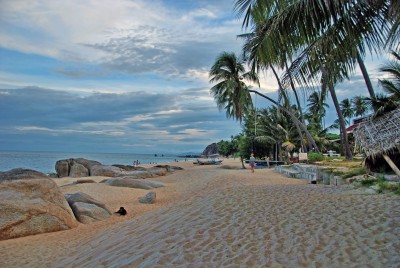

Ko Samui

Search

Ko Samui
An island of great natural beauty and variety, Samui is home to about 40,000 full-time inhabitants, 90% of whom are Buddhist. The palm fringed shoreline and coconut and fruit cultivation of the coastal lowlands rise to a central granite massive, the slopes of which are cloaked in virgin rainforest.
At 247km˛ Samui is the third largest island in Thailand and the largest island in an archipelago of over 80 (mostly uninhabited) islands which form the Ang Thong National Marine Park, a kayaking and snorkeling paradise. At 25km long and 21km wide, Samui is big enough for serious exploration by the adventurous and fit, but can be circumnavigated in just a couple of hours by motorbike or car.
The island was probably first inhabited about 15 centuries ago, settled by fishermen from the Malay Peninsula and Southern China. It appears on Chinese maps dating back to 1687, under the name Pulo Cornam. The name Samui is mysterious in itself. Perhaps it is an extension of the name of one of the native trees, mui, or it is a corruption of the Chinese word Saboey, meaning "safe haven".
Until the late 20th century, Samui was an isolated self-sufficient community, having little connection with the mainland of Thailand. The island was even without roads until the early 1970s, and the 15km journey from one side of the island to the other involved a whole-day trek through the mountainous central jungles.
In the early 1970s the first backpackers traveling on the back of a coconut boat arrived on Ko Samui. For years after that the island just had a few bungalows and a trickle of travelers. Things started to change in the early 1990s when tourists started arriving in full boats and since then the place grew substantially. Samui is now the second most popular place as an island destination in Thailand (first is Phuket). Ko Samui may not be the country’s most beautiful island but it is still an oasis of natural beauty with its white sandy beaches, dazzling coral, luscious lagoons, picturesque waterfalls, swaying coconut trees and crystal clear water. The water at Bophut beach, though, is often murky, especially around December.
Unfortunately, development on Ko Samui is starting to take its toll and the beaches of Chaweng and Lamai are overcrowded in the high season.
At 247km˛ Samui is the third largest island in Thailand and the largest island in an archipelago of over 80 (mostly uninhabited) islands which form the Ang Thong National Marine Park, a kayaking and snorkeling paradise. At 25km long and 21km wide, Samui is big enough for serious exploration by the adventurous and fit, but can be circumnavigated in just a couple of hours by motorbike or car.
The island was probably first inhabited about 15 centuries ago, settled by fishermen from the Malay Peninsula and Southern China. It appears on Chinese maps dating back to 1687, under the name Pulo Cornam. The name Samui is mysterious in itself. Perhaps it is an extension of the name of one of the native trees, mui, or it is a corruption of the Chinese word Saboey, meaning "safe haven".
Until the late 20th century, Samui was an isolated self-sufficient community, having little connection with the mainland of Thailand. The island was even without roads until the early 1970s, and the 15km journey from one side of the island to the other involved a whole-day trek through the mountainous central jungles.
In the early 1970s the first backpackers traveling on the back of a coconut boat arrived on Ko Samui. For years after that the island just had a few bungalows and a trickle of travelers. Things started to change in the early 1990s when tourists started arriving in full boats and since then the place grew substantially. Samui is now the second most popular place as an island destination in Thailand (first is Phuket). Ko Samui may not be the country’s most beautiful island but it is still an oasis of natural beauty with its white sandy beaches, dazzling coral, luscious lagoons, picturesque waterfalls, swaying coconut trees and crystal clear water. The water at Bophut beach, though, is often murky, especially around December.
Unfortunately, development on Ko Samui is starting to take its toll and the beaches of Chaweng and Lamai are overcrowded in the high season.

